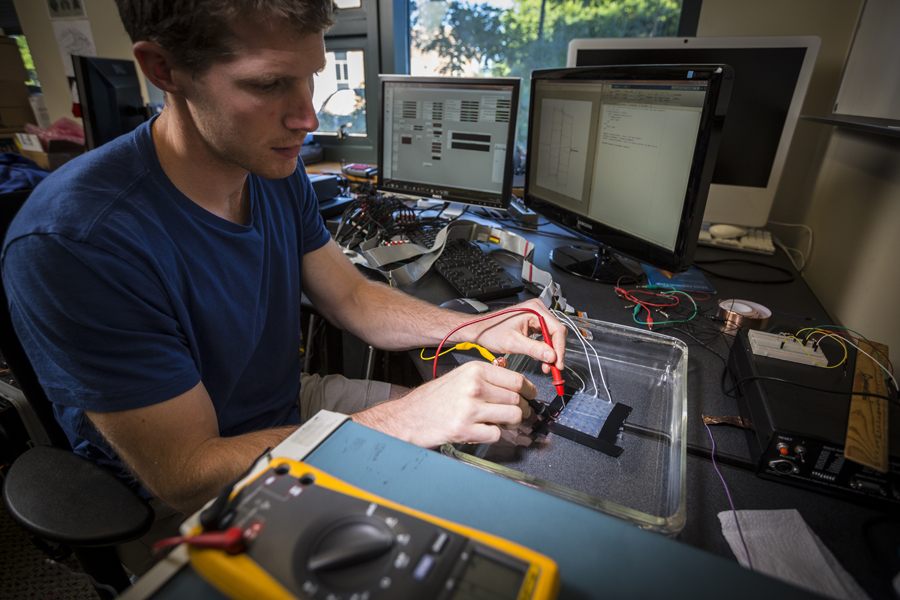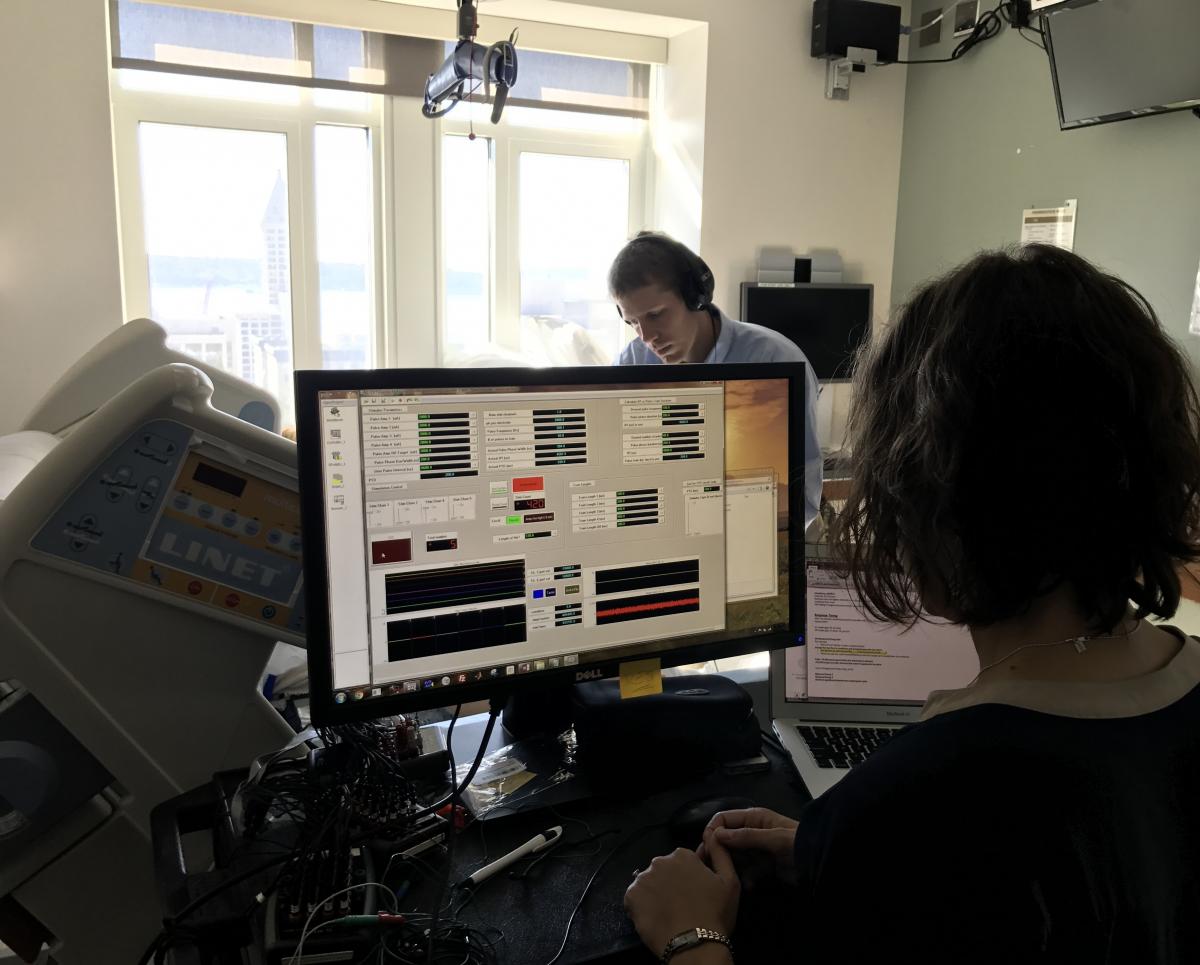The importance of touch
 Imagine moving through your morning routine without the sense of touch. Would you be able to brush your teeth as effectively, pour your coffee without dropping the mug, or tie your shoes? While this may seem easy (you can still see everything you’re doing!) it is actually quite difficult. Our vision seems to integrate seamlessly with our other senses and our experience of our surroundings, but our brains actually process vision much more slowly than touch. Beyond its speed, the tactile sensations of touch, along with proprioception (our knowledge of where our bodies and limbs are in space), also informs us of the material of the toothbrush that we picked up, the force of our grasp on an egg, if our coffee mug is about to slip from our fingers and more. All this information is essential to effectively manipulate objects. But for individuals with spinal cord injuries or amputations, their sense of touch and proprioception has been altered, or lost altogether, in the affected limbs.
Imagine moving through your morning routine without the sense of touch. Would you be able to brush your teeth as effectively, pour your coffee without dropping the mug, or tie your shoes? While this may seem easy (you can still see everything you’re doing!) it is actually quite difficult. Our vision seems to integrate seamlessly with our other senses and our experience of our surroundings, but our brains actually process vision much more slowly than touch. Beyond its speed, the tactile sensations of touch, along with proprioception (our knowledge of where our bodies and limbs are in space), also informs us of the material of the toothbrush that we picked up, the force of our grasp on an egg, if our coffee mug is about to slip from our fingers and more. All this information is essential to effectively manipulate objects. But for individuals with spinal cord injuries or amputations, their sense of touch and proprioception has been altered, or lost altogether, in the affected limbs.
Using brain surface stimulation to provide a sense of “touch”
 Here is where the University of Washington (UW) GRID Lab, led by Dr. Jeffrey Ojemann, Vice-Chair for Research and Discovery and Professor of Neurological Surgery at UW Medicine and member of the Center for Sensorimotor Neural Engineering, comes in. The GRID Lab team is using electrical stimulation of the brain’s surface to investigate how to restore sensory feedback, the type of feedback you would need to handle a mug, feed and bathe yourself, or use the restroom. Only a handful of labs in the United States have the opportunity to research sensory feedback through direct electrical brain stimulation in humans like we can.
Here is where the University of Washington (UW) GRID Lab, led by Dr. Jeffrey Ojemann, Vice-Chair for Research and Discovery and Professor of Neurological Surgery at UW Medicine and member of the Center for Sensorimotor Neural Engineering, comes in. The GRID Lab team is using electrical stimulation of the brain’s surface to investigate how to restore sensory feedback, the type of feedback you would need to handle a mug, feed and bathe yourself, or use the restroom. Only a handful of labs in the United States have the opportunity to research sensory feedback through direct electrical brain stimulation in humans like we can.
By electrically stimulating the surface of the brain through electrocorticography (ECoG) electrodes, we can provide touch feedback to our research participants. When electrical stimulation is delivered over the hand area of the primary somatosensory cortex (the part of the brain that processes touch information from the hand), subjects experience a sensation on their hand, even though nothing has physically touched it. They have described the sensations as a “vibration,” “little pulse,” and “buzz.” Sometimes they elaborate: “if I was at a ballgame it’d be noticeable like hair tickling your face,” and “feels really light, but like when you hit [your] funny bone, tingling.” Collecting qualitative descriptions of human perceptions of brain stimulation is one of the greatest benefits of working with human subjects in this research. Other labs have done similar tests in monkeys, but monkeys can’t describe sensations, limiting what we can learn on behalf of future human users.
Human research is key
 Our research with humans is not without limitations. Since this research is still exploratory and involves implanting electrodes on or into the brain, only a limited number of patients can participate in research. Other labs in the United States have focused on just a few subjects with severe paralysis (at most, three per lab) who are willing to undergo elective neurosurgery to implant long-term electrodes. We have instead focused on patients who are undergoing neurosurgery for intractable epilepsy (which is not sufficiently controlled through medication). ECoG electrodes are temporarily surgically implanted on the surface of these patient’s brains to locate the seizure’s origin for removal. While in the hospital, these patients may consent to our research. Working with this population gives us the opportunity to work with more patients, albeit for shorter periods of time (one week, as compared to months or years of work with paralyzed patients). Despite the tradeoffs, one thing is certain: human research is key to our understanding of how people perceive electrical stimulation of the brain, and how we may use it to restore tactile sensation to users and help them drink that morning cup of coffee on their own.
Our research with humans is not without limitations. Since this research is still exploratory and involves implanting electrodes on or into the brain, only a limited number of patients can participate in research. Other labs in the United States have focused on just a few subjects with severe paralysis (at most, three per lab) who are willing to undergo elective neurosurgery to implant long-term electrodes. We have instead focused on patients who are undergoing neurosurgery for intractable epilepsy (which is not sufficiently controlled through medication). ECoG electrodes are temporarily surgically implanted on the surface of these patient’s brains to locate the seizure’s origin for removal. While in the hospital, these patients may consent to our research. Working with this population gives us the opportunity to work with more patients, albeit for shorter periods of time (one week, as compared to months or years of work with paralyzed patients). Despite the tradeoffs, one thing is certain: human research is key to our understanding of how people perceive electrical stimulation of the brain, and how we may use it to restore tactile sensation to users and help them drink that morning cup of coffee on their own.
 Pictured at left, Jeneva Cronin is a UW/CSNE bioengineering doctoral student. For more information about Jeneva Cronin’s, GRID Lab’s and the CSNE’s ground-breaking research in the area of sensory feedback, read “For the first time in humans, researchers use brain surface stimulation to provide ‘touch’ feedback to direct movement.”
Pictured at left, Jeneva Cronin is a UW/CSNE bioengineering doctoral student. For more information about Jeneva Cronin’s, GRID Lab’s and the CSNE’s ground-breaking research in the area of sensory feedback, read “For the first time in humans, researchers use brain surface stimulation to provide ‘touch’ feedback to direct movement.”
